In the construction industry, preconstruction is infamous for coordination issues. Design changes often leave owners, architects, and contractors misaligned—one team updates plans while another is stuck with old versions, leading to unexpected work and rework. Value engineering ideas are scattered in spreadsheets, and critical decisions get buried in emails, making the process fragmented.
General contractors struggle to assemble bid packages and chase subcontractor quotes, manually sifting through bids—a stressful, time-consuming task that can lead to missing trade scopes or deadlines and surprise budget issues. Clearly, better systems are needed to keep teams in sync and streamline the invite-to-bid process.
Two modern tools—Join and Downtobid—address these challenges from different angles. Both help organize preconstruction, each focusing on specific problems. Here’s how they tackle misalignment, inefficient bidding, scope gaps, and messy change tracking—and where they complement each other for GCs and subcontractors.
Downtobid: AI-Powered Bid Management
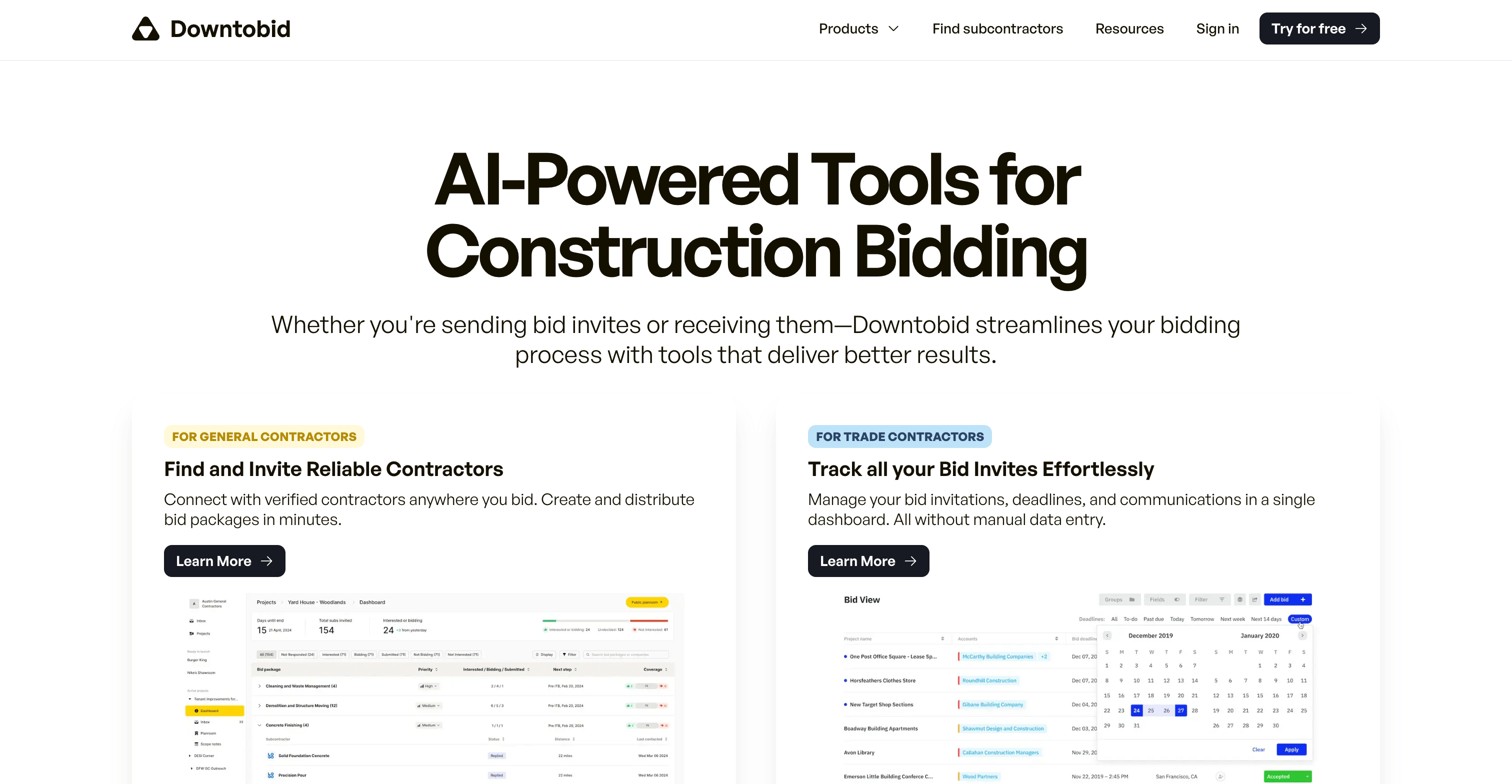
Downtobid is an AI-powered construction bidding platform that streamlines how GCs prepare bids and connect with subcontractors. Unlike Join, which focuses on design collaboration, Downtobid targets the invite-to-bid workflow: distributing plans, gathering quotes, and ensuring full trade coverage.
Its machine learning analyzes project plans, identifies needed scopes, and finds qualified subs—automating the tedious tasks of reading drawings, breaking out bid packages, and managing outreach.
GCs can upload plans and let Downtobid’s AI send personalized invitations to relevant subs from a network of 57,000+, saving time and reducing manual admin work. Invitations come directly from the GC’s email, increasing open rates, and subs can submit bids for free via a linked planroom. Downtobid is free for subs to bid and only charges for extra features like a personal bid board.
Claim a free demo here and see how Downtobid works.
Core Features and Workflow Focus For General Contractors
Downtobid’s process starts when a GC uploads project drawings for bidding. Its AI scans the plans to identify relevant trades (like steel, concrete, HVAC) and drafts scope notes, which the estimator can refine.
Downtobid then suggests subcontractors for each trade from its database or the GC’s own list, merging and flagging duplicates.
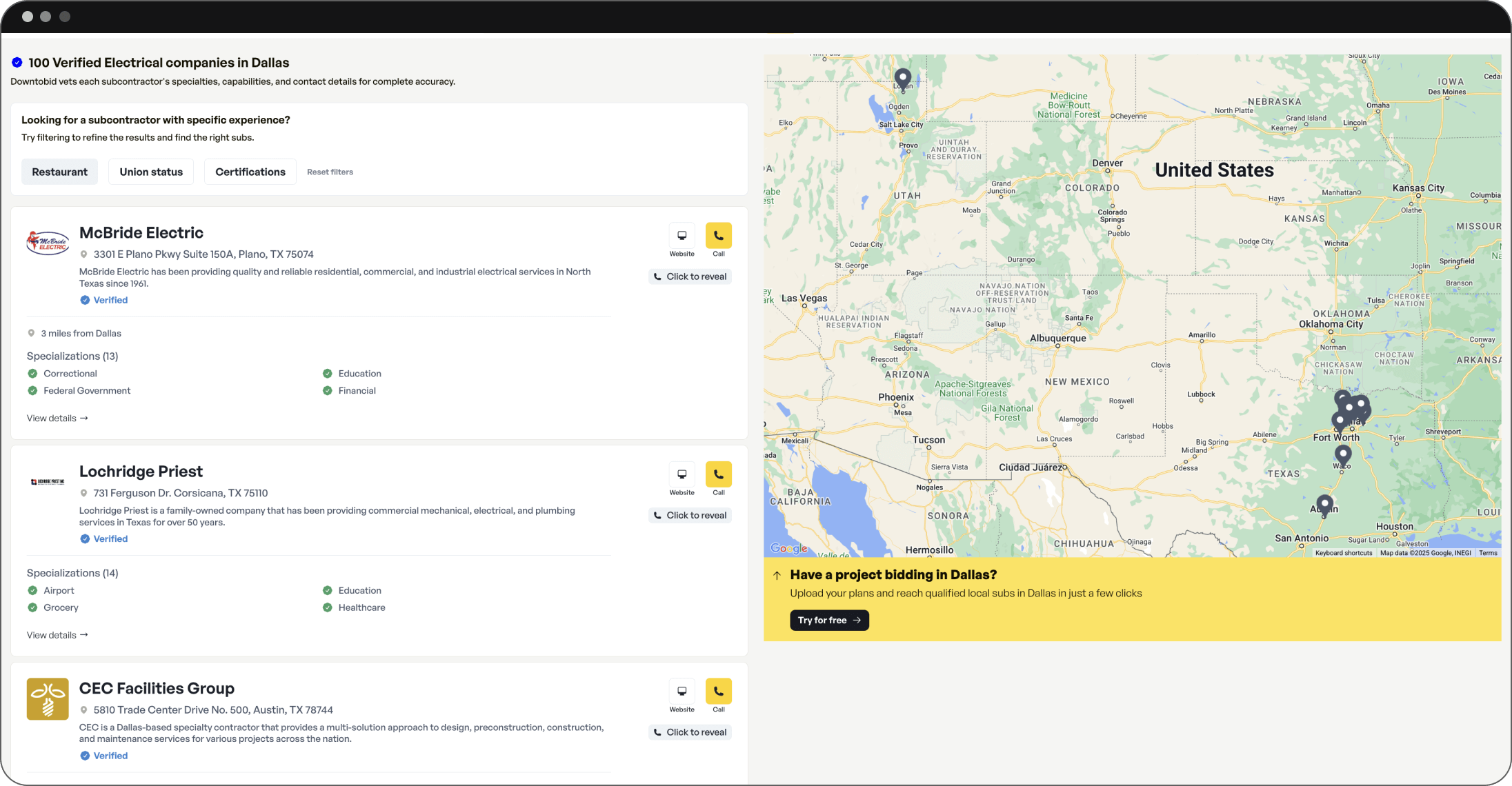
Once subs are selected, the platform sends each a personalized ITB email with relevant documents and a tailored scope summary. This personal approach, using the GC’s branding, boosts response rates.
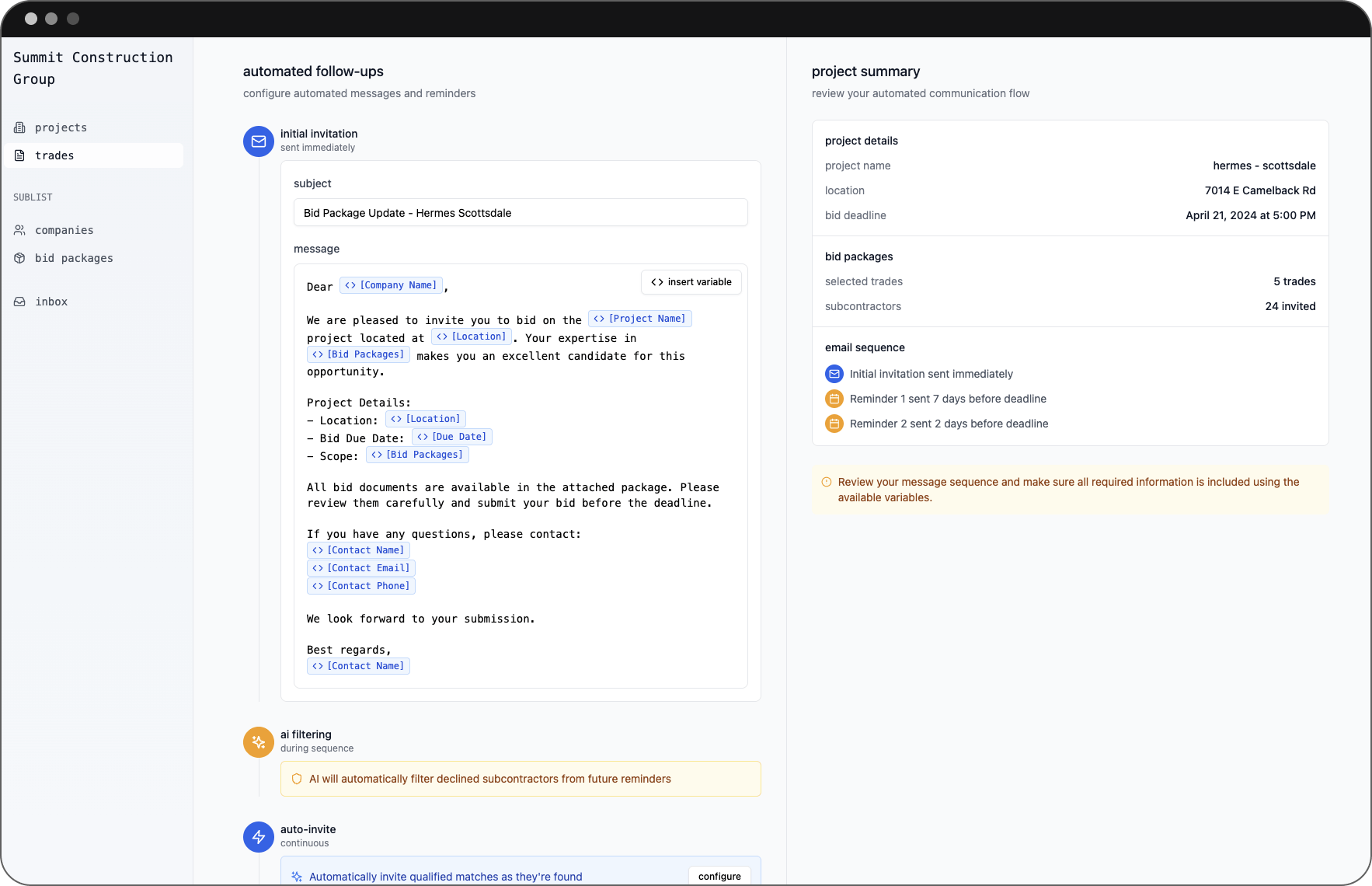
As bids come in, Downtobid offers a real-time dashboard to track responses and see coverage by trade, making it easy to spot gaps or know when to follow up. Bid leveling tools let you compare responses side by side. While Downtobid isn’t an estimating tool, it ensures every scope has at least one bid and highlights any missing coverage.
Advanced features include auto-reminders for subs and filtering out those who decline. In short, Downtobid automates package creation, invite distribution, and bid tracking, making the GC’s bidding phase much more efficient.
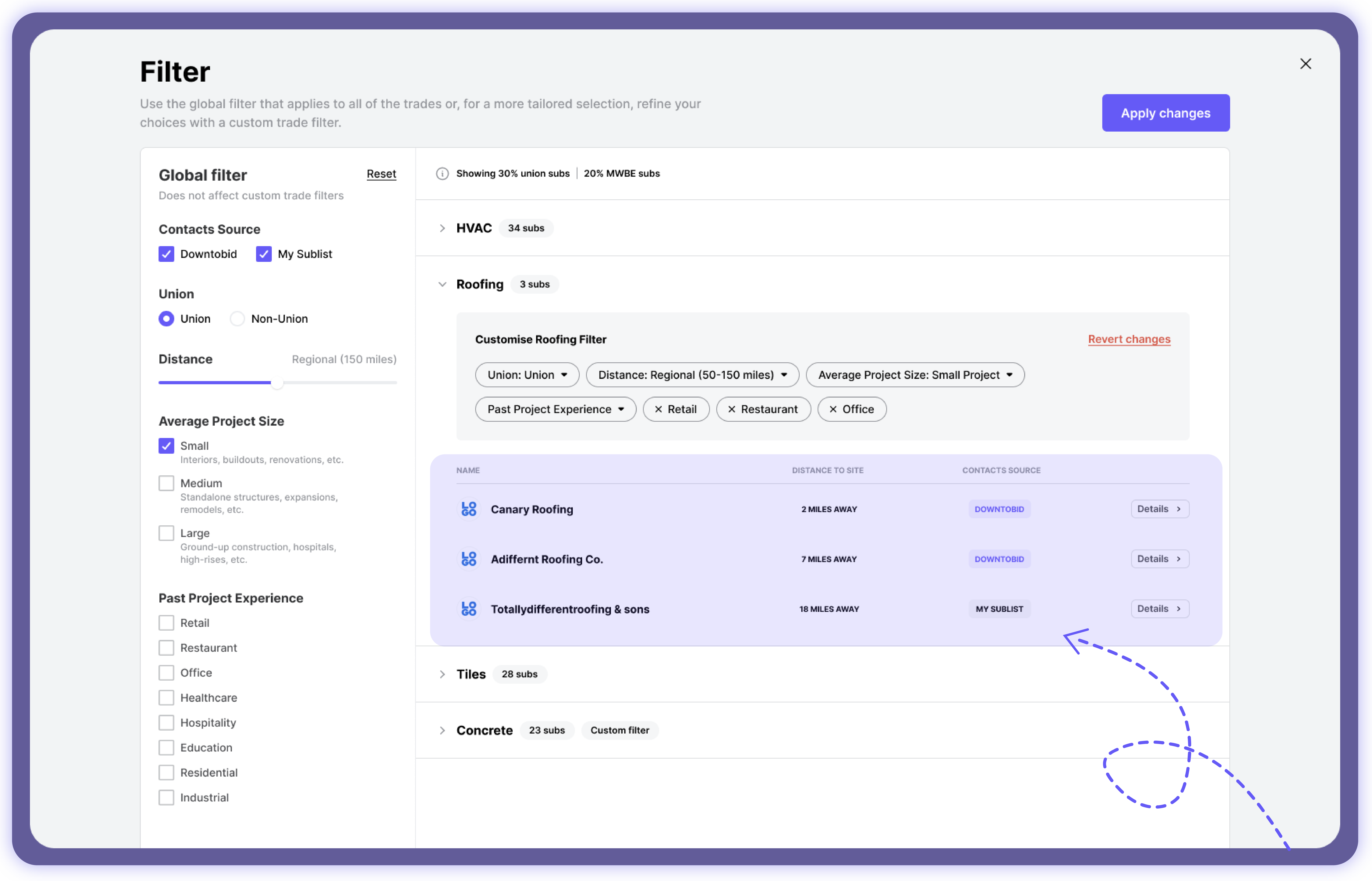
Target Users
Downtobid serves both GCs and subcontractors. For GCs—including estimators, bid coordinators, and precon managers—it streamlines sending ITBs and organizing bids, saving significant time, especially for those with high bid volumes or tight deadlines. GCs bidding in new regions also benefit from its network of local subs suggested by AI.
For subcontractors, Downtobid’s Bid Board aggregates all bid invitations in one dashboard, making it easy to track opportunities and deadlines, and avoid missed bids or double booking.
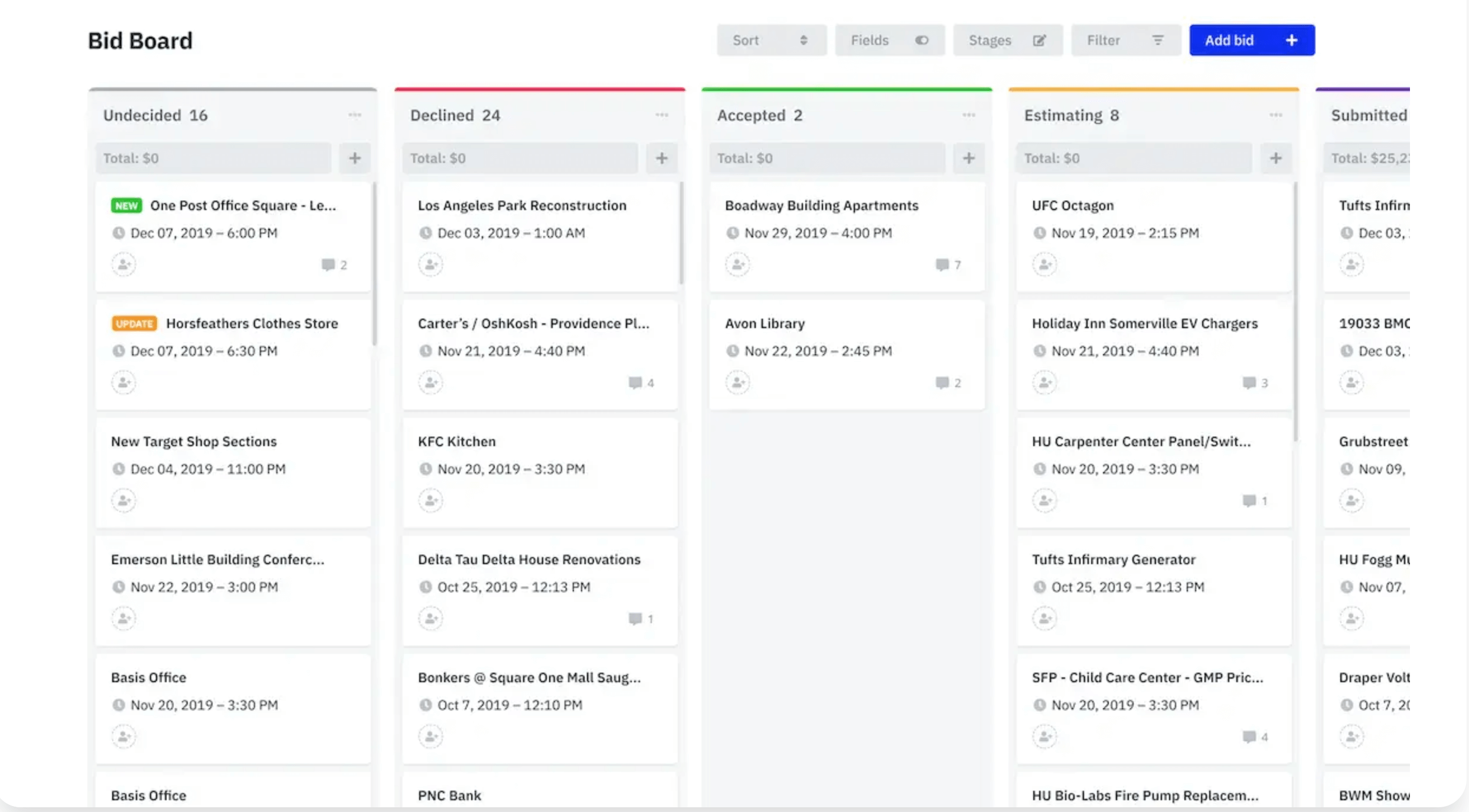
Subs can submit bids for free, while advanced tools and new opportunities are available via subscription. Downtobid targets GCs seeking faster, organized bidding and subs who want to manage ITBs and connect with more GCs.
Strengths
Downtobid’s biggest advantage is automation, saving estimators hours on bid setup and scope breakdown. Its AI flags every trade, reducing the risk of missed scopes and costly change orders. Personalized invites increase subcontractor participation, often doubling the number of bids per package.
The intuitive dashboard simplifies tracking and comparison. Subs benefit from managing all bids in one place, cutting down on confusion and missed deadlines. Downtobid doesn’t replace estimating expertise, but it handles time-consuming tasks and provides better data for decisions
Limitations
Downtobid has its limits. Its subcontractor network is newer and may not cover every region or niche trade, so GCs might still invite some subs manually. AI suggestions often need human review to catch errors, especially on unusual projects.
Downtobid is focused on bidding and doesn’t deeply integrate with other software, so GCs may need to transfer data elsewhere. Subs could face a learning curve with its planroom features, and some may hesitate to use yet another platform. Reliable performance is critical—any outages or email issues could be disruptive, though major problems haven’t been widely reported.
Bottom line: Downtobid speeds up bidding with AI, but still requires oversight and works best alongside established estimating practices.
Join: Collaborative Preconstruction Platform
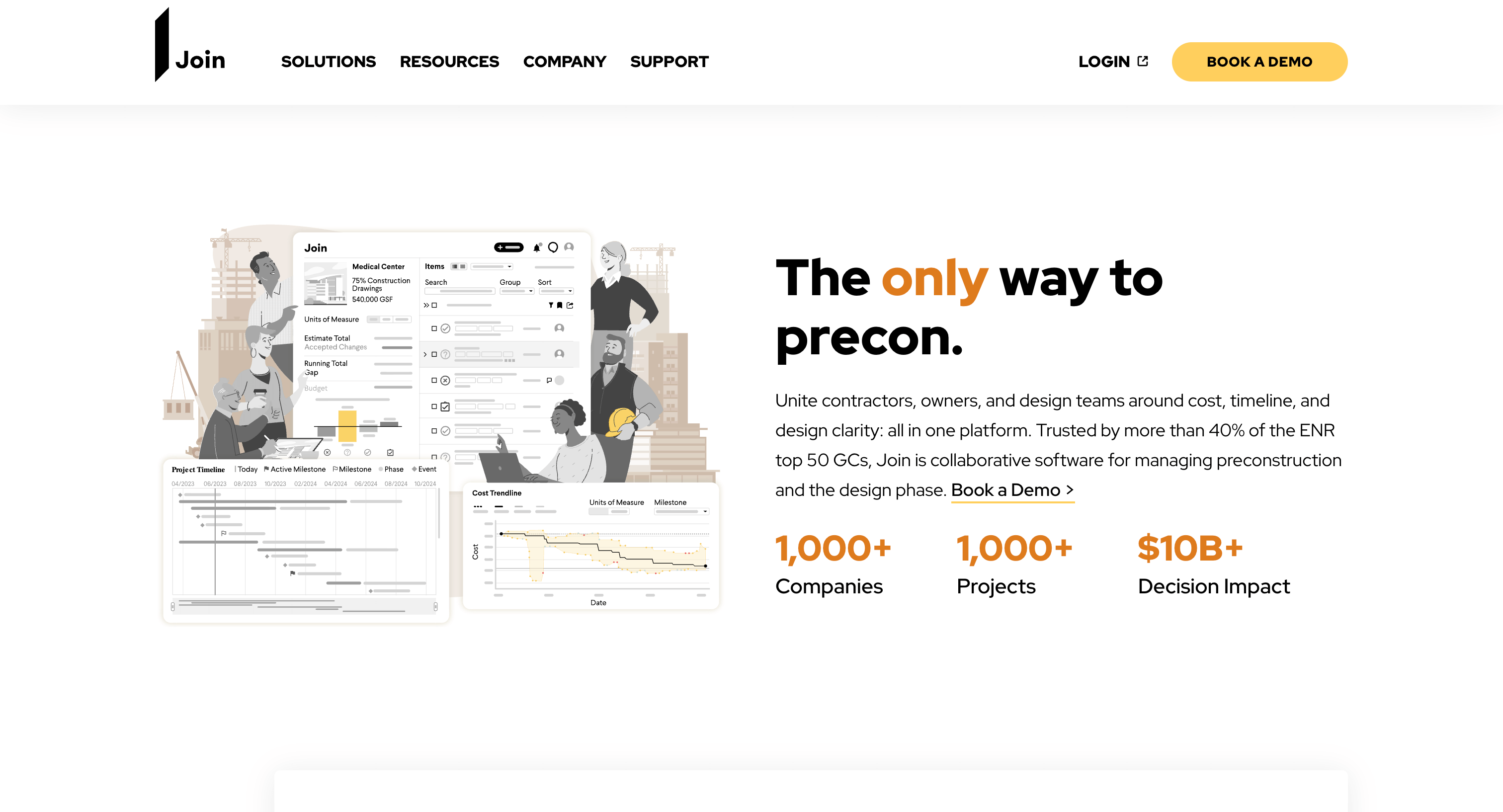
Join is a cloud-based platform designed to unite contractors, owners, and design teams in a shared workspace for project decision-making It acts as a digital meeting table during preconstruction, replacing endless email chains and scattered spreadsheets. All options and changes are logged as “items” in Join, visible to everyone.
Team members can suggest scope changes or value engineering ideas, attach drawings or specs, and tag each item with estimated cost or schedule impact. Join tracks every item’s lifecycle—who’s responsible, discussions, approvals or rejections—with a full history recorded. This audit trail provides a real-time single source of truth for design-phase changes, eliminating miscommunication and version confusion. Find out more here.
Core Features and Workflow Focus:
Join is designed for design-phase collaboration and transparency. Its standout features include interactive cost tracking, scenario comparisons, and visual cost trend charts that update with each decision. Users can see the project’s Cost Trendline across milestones, watching the budget shift as VE items are accepted or rejected.
This visibility keeps everyone aware of the real impact of changes. Join also manages contingency and allowance tracking and integrates with estimating tools—so detailed estimates can be imported to anchor cost data. It isn’t estimating software itself, but acts as a centralized layer that lets teams review estimate outcomes together.
Target Users
Join is mainly used by general contractor preconstruction teams and their owner/design counterparts. A GC precon manager or estimator typically sets up Join and invites the owner’s reps and designers to collaborate.
Owners and architects review options and give input to keep the design on budget and on track. GC project managers and execs get dashboards showing pending decisions and costs, while exec-level views help spot project risks. Trade partners, like design-assist subs, can join in to provide pricing, but Join’s core audience is the OAC team.
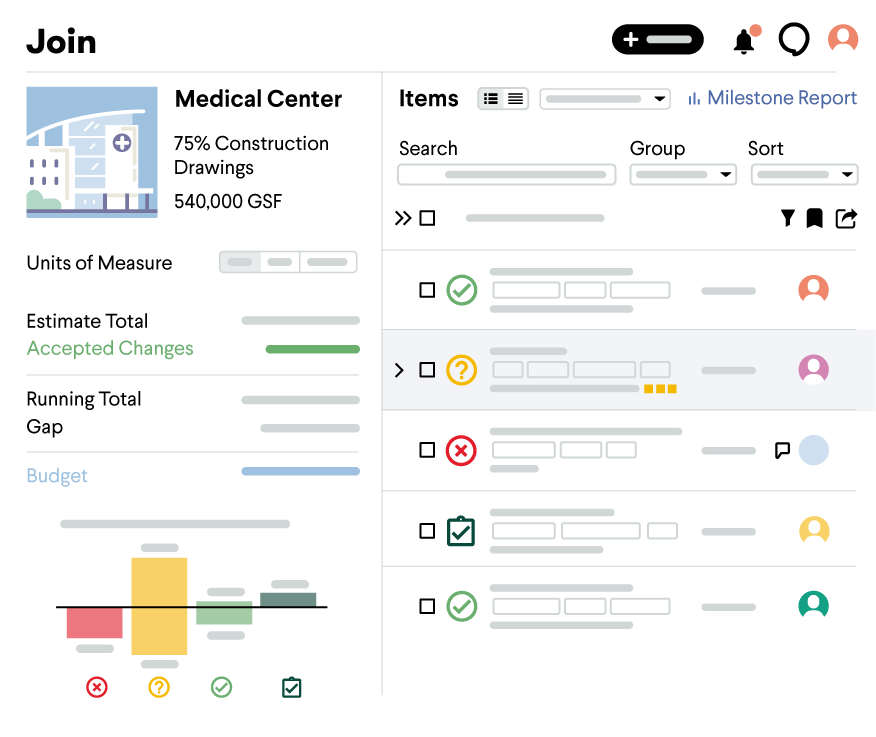
It’s built for GCs who need ongoing collaboration especially on collaborative delivery methods like CMAR, Design-Build, Target Value Design or Integrated Project Delivery. Over 40% of ENR Top 50 GCs use Join, showing its strong value for decision-tracking.
Strengths
Join excels at providing design clarity during iterations. By centralizing thousands of decisions, it eliminates confusion like "Which email had the final lobby flooring answer?" Every team member sees the same information, reducing friction and improving transparency. The platform is visual and user-friendly, so non-technical project stakeholders can quickly grasp budget status.
Real-time cost updates and clear change records help keep projects on budget and schedule—teams avoid late surprises because cost impacts are always visible. Join also ensures accountability: item assignments and audit trails show who owes input and when decisions were finalized, reducing finger-pointing.
It fosters better communication and a more cooperative atmosphere. GCs benefit from knowledge retention too—all decisions and cost data become a database for future projects, enabling templates and benchmarks for enterprise use.
Limitations
Join is great for collaboration and decision tracking, but doesn’t handle bidding or subcontractor management—GCs need separate tools like Downtobid for those tasks. Most firms use Join alongside other platforms, so some duplicate work exists, and its value drops if not kept updated. Join only works if everyone actually uses it; otherwise, GCs must manually add records.
It’s easy to set up but won’t produce estimates or automate tasks—it’s a facilitator, depending on accurate input. In short, Join aligns teams and tracks decisions, but relies on other software for bidding and estimating.Join streamlines collaboration and decision tracking but doesn’t cover bidding or subcontractor management—GCs need other tools like Downtobid for that.
Most firms use Join with other software, so there can be duplicate data entry and its usefulness drops if updates are missed. Its impact relies on all stakeholders using it; if not, GCs must update records manually. Join is easy to set up but doesn’t produce estimates or automate work—it’s a record-keeper, not a bidding platform. Ultimately, Join focuses on team alignment and decision tracking, while other tools handle bidding and detailed estimating.
Complementary vs. Competing Solutions
Join and Downtobid complement each other, handling different construction phases within preconstruction. Join helps teams align during design and budgeting, tracking decisions and changes. Once the project is ready for bidding, Downtobid takes over, managing outreach to subs and tracking bid coverage.
Join fixes upstream misalignment; Downtobid streamlines downstream bidding. There’s little overlap: Join isn’t for managing bids, and Downtobid isn’t for design collaboration.
Built For Bidding Vs Design Teams
Some teams need only one—design-build firms may prefer Join, while hard-bid GCs often choose Downtobid. Both tools address inefficiencies email and spreadsheets can't, and together they close major workflow gaps, though firms can adopt whichever best fits their needs.Join and Downtobid complement each other, handling different stages of preconstruction.
Join is used first, keeping design teams aligned and tracking changes; Downtobid comes next, managing bid invites and subcontractor coverage. Each tool fixes pain points in its stage—Join addresses design misalignment, Downtobid streamlines bidding.
They don’t overlap: Join isn’t for bidding, and Downtobid isn’t for design collaboration. Some teams need only one, depending on their workflow. Used together, they create a smoother process, but companies can choose based on where their biggest challenges lie
Conclusion: Choosing the Right Tool for Better Outcomes
Ultimately, the choice between Join and Downtobid (or choosing both) comes down to what problems you’re trying to solve:
- Use Join to align stakeholders and track design decisions in preconstruction—perfect for collaborative GCs, managers, and estimators on complex projects with frequent changes and owner input. It brings clarity, transparency, and helps prevent costly surprises by making all impacts visible, keeping everyone on the same page
- Use Downtobid to automate bidding and subcontractor outreach—ideal for GCs and estimators who want to save time, avoid missed scopes, and boost subcontractor participation. The platform centralizes bid invites and responses, helping teams manage dozens of bids efficiently. Subcontractors benefit from tools that organize all incoming bids in one dashboard for free, streamlining their workflow and improving follow-through
- Use Join and Downtobid together for a full preconstruction solution. Join clarifies scope and aligns the team during design, ensuring all decisions are tracked and budgets stay accurate. Once design is set, Downtobid takes over to automate bidding and ensure every scope gets competitive coverage. Together, they reduce confusion, close gaps, and move projects smoothly from planning to bid day.
Whether using Join, Downtobid, or both, the goal is to solve real preconstruction problems with construction technology while keeping teamwork central. Join targets design-phase misalignment; Downtobid fixes bid-phase headaches. Choose the tool that fits your biggest pain point—or execute both to keep everyone aligned and every scope covered for predictable, successful projects.